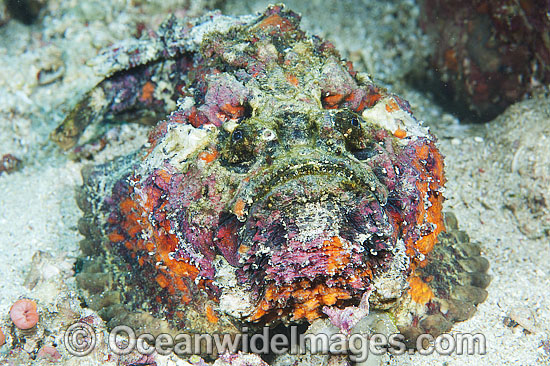
Synanceia verrucosa
FAMILY
Synanceiidae
TAXONOMY
Synanceia verrucosa Bloch and Schneider, 1801, Indian Ocean.
OTHER COMMON NAMES
English: Stonefish, dornorn; French: Poisson pierre commun;
Japanese: Oni-darumaokoze.
PHYSICAL CHARACTERISTICS
Reaches 15.7 in (40 cm) maximum length. The reef stonefish is
among the best-camouflaged species in the world. Most of
these fishes look like encrusted rocks or pieces of coral. Most
specimens are dark brown or gray, but they usually have
patches of yellow, red, or orange.
DISTRIBUTION
This is the most widely distributed stonefish. It can be found
throughout the Indo-Pacific from Africa to the Tuomoto
Archipelago.
HABITAT
Usually found living among rubble, on coral bottoms, or under
rocks or ledges. They also are found on sandy or muddy bottoms,
where they often bury themselves.
BEHAVIOR
This is the world’s most venomous fish. Unlike most scorpaenoids,
the stonefishes have grooves in their dorsal spines
that act like syringes to deliver venom.
FEEDING ECOLOGY AND DIET
This species feeds primarily on small fishes and crustaceans
that swim by.
REPRODUCTIVE BIOLOGY
Stonefishes are typically solitary creatures, but they do form
larger aggregations for mating. The reef stonefish has external
fertilization, and produces comparatively large eggs.
CONSERVATION STATUS
Not listed by the IUCN.
SIGNIFICANCE TO HUMANS
Despite the extreme danger associated with collecting this
species, there are commercial fisheries for both dead and live
fish markets. In addition to their commercial fishery, stonefishes
make their way into the aquarium trade. The sting of the
stone fish is extremely painful and is followed by rapid swelling
around the wound. The severity of the response is related to
the depth of the penetration by the spines. The treatment of
the wound consists of bathing the stung area in very hot water
until the victim can be hospitalized. For more serious stings, it
is often advisable for stonefish antivenin to be given intramuscularly.
The stonefish antivenin is composed of purified antibodies
against stonefish venoms and venom components. These
antibodies are harvested from laboratory animals, which are
given small doses of the venom. Eventually, these animals build
up a tolerance to the venom, which allows them to produce the
large quantity of venom antibodies required for the antivenin.
Other popular Animals
Photo Gallery of - Reef stonefish





 Animalia Life
Animalia Life